Sustainable Tourism in the Developing World: An Essay
VerifiedAdded on 2023/06/08
|11
|2659
|366
Essay
AI Summary
This essay examines the sustainability of the tourism industry in the developing world, arguing that it is often unsustainable due to significant environmental concerns. The assignment explores various issues, including pollution from waste, deforestation for construction, and the depletion of natural resources. It also discusses the global impact of tourism, such as ozone layer depletion, climate change, and the alteration of biodiversity. The essay further analyzes how environmental degradation impacts the tourism industry itself, highlighting the importance of ecotourism and sustainable development strategies to mitigate the negative effects and ensure the long-term viability of the industry. Examples from regions like the Caribbean and Australia are used to illustrate these points, emphasizing the need for responsible practices and conservation efforts.
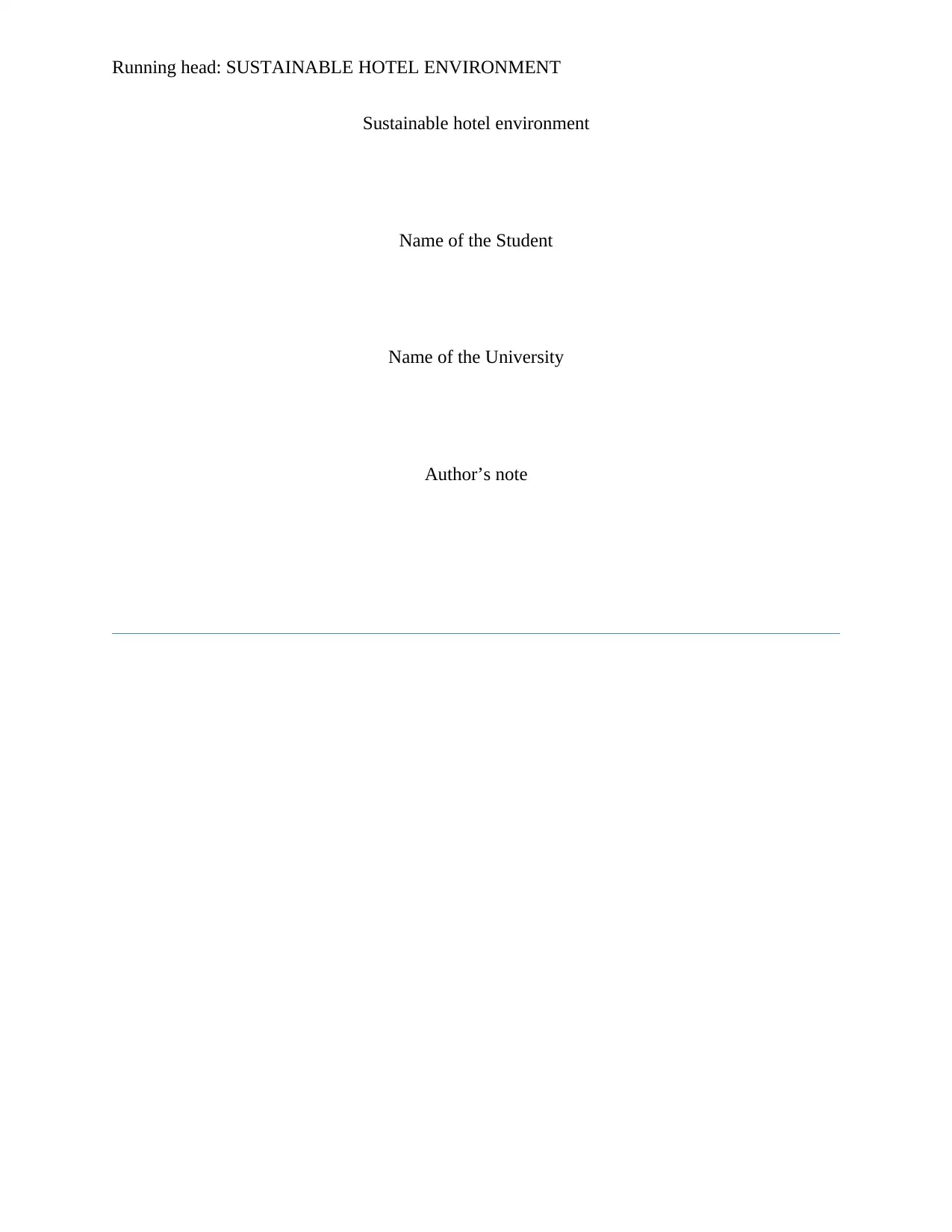
Running head: SUSTAINABLE HOTEL ENVIRONMENT
Sustainable hotel environment
Name of the Student
Name of the University
Author’s note
Sustainable hotel environment
Name of the Student
Name of the University
Author’s note
Paraphrase This Document
Need a fresh take? Get an instant paraphrase of this document with our AI Paraphraser
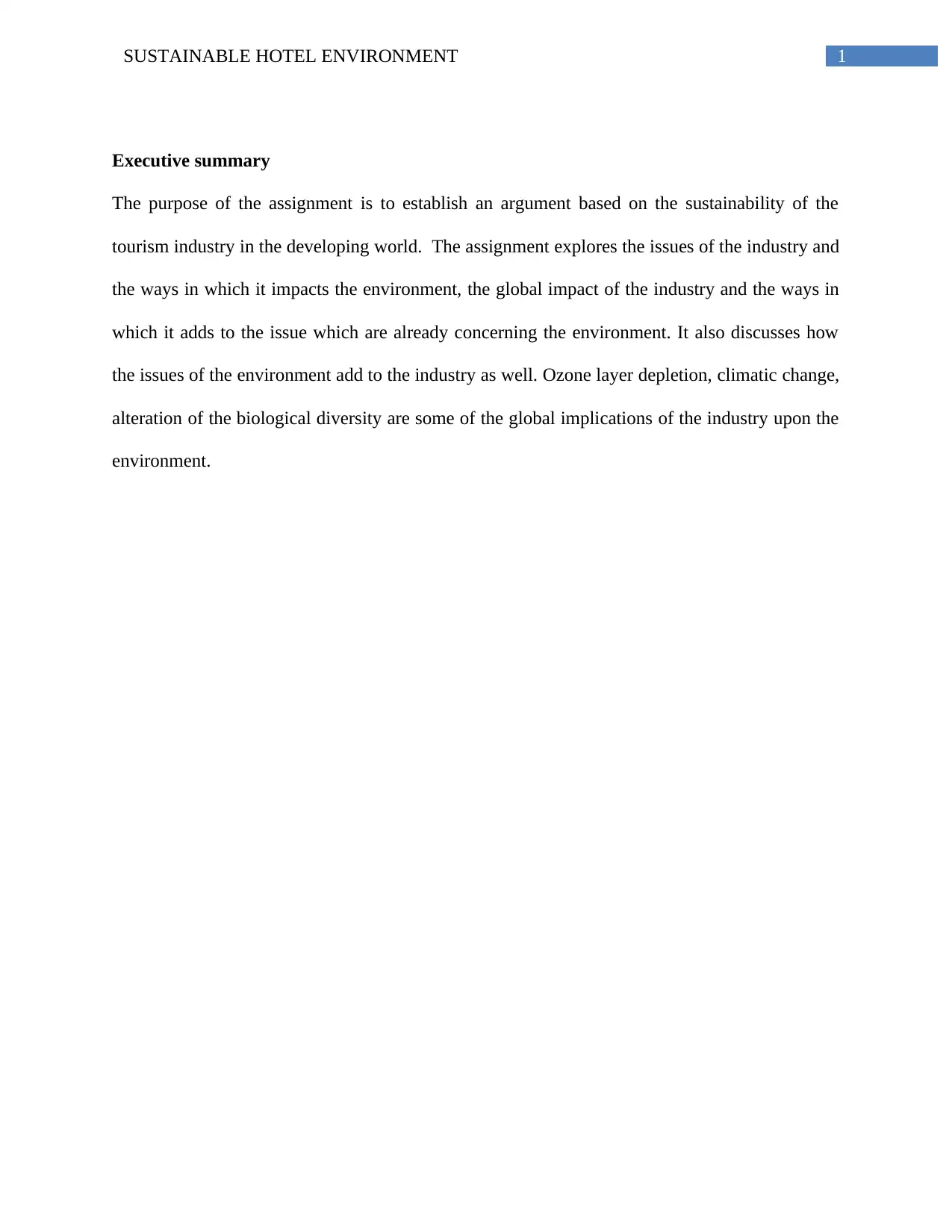
1SUSTAINABLE HOTEL ENVIRONMENT
Executive summary
The purpose of the assignment is to establish an argument based on the sustainability of the
tourism industry in the developing world. The assignment explores the issues of the industry and
the ways in which it impacts the environment, the global impact of the industry and the ways in
which it adds to the issue which are already concerning the environment. It also discusses how
the issues of the environment add to the industry as well. Ozone layer depletion, climatic change,
alteration of the biological diversity are some of the global implications of the industry upon the
environment.
Executive summary
The purpose of the assignment is to establish an argument based on the sustainability of the
tourism industry in the developing world. The assignment explores the issues of the industry and
the ways in which it impacts the environment, the global impact of the industry and the ways in
which it adds to the issue which are already concerning the environment. It also discusses how
the issues of the environment add to the industry as well. Ozone layer depletion, climatic change,
alteration of the biological diversity are some of the global implications of the industry upon the
environment.
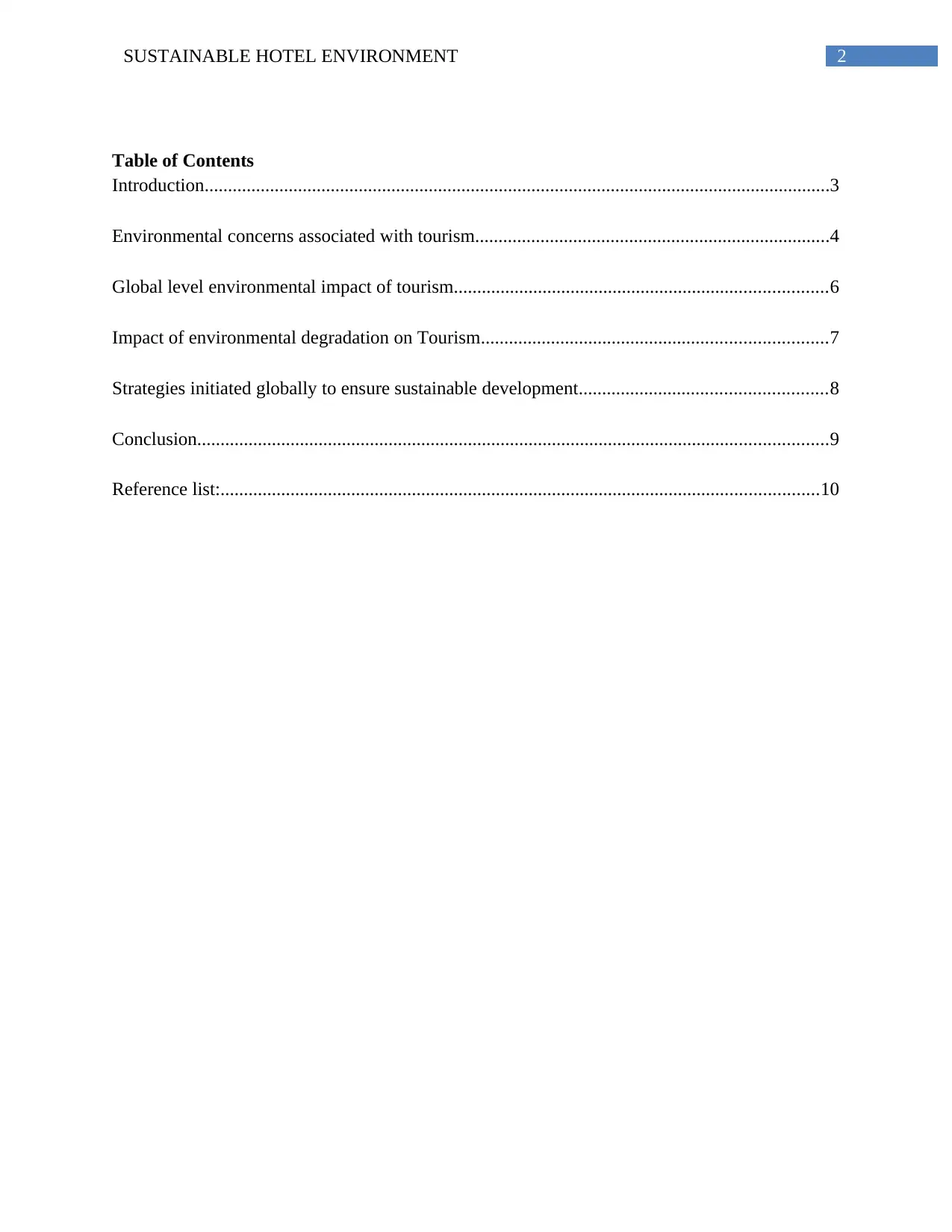
2SUSTAINABLE HOTEL ENVIRONMENT
Table of Contents
Introduction......................................................................................................................................3
Environmental concerns associated with tourism............................................................................4
Global level environmental impact of tourism................................................................................6
Impact of environmental degradation on Tourism..........................................................................7
Strategies initiated globally to ensure sustainable development.....................................................8
Conclusion.......................................................................................................................................9
Reference list:................................................................................................................................10
Table of Contents
Introduction......................................................................................................................................3
Environmental concerns associated with tourism............................................................................4
Global level environmental impact of tourism................................................................................6
Impact of environmental degradation on Tourism..........................................................................7
Strategies initiated globally to ensure sustainable development.....................................................8
Conclusion.......................................................................................................................................9
Reference list:................................................................................................................................10
⊘ This is a preview!⊘
Do you want full access?
Subscribe today to unlock all pages.

Trusted by 1+ million students worldwide
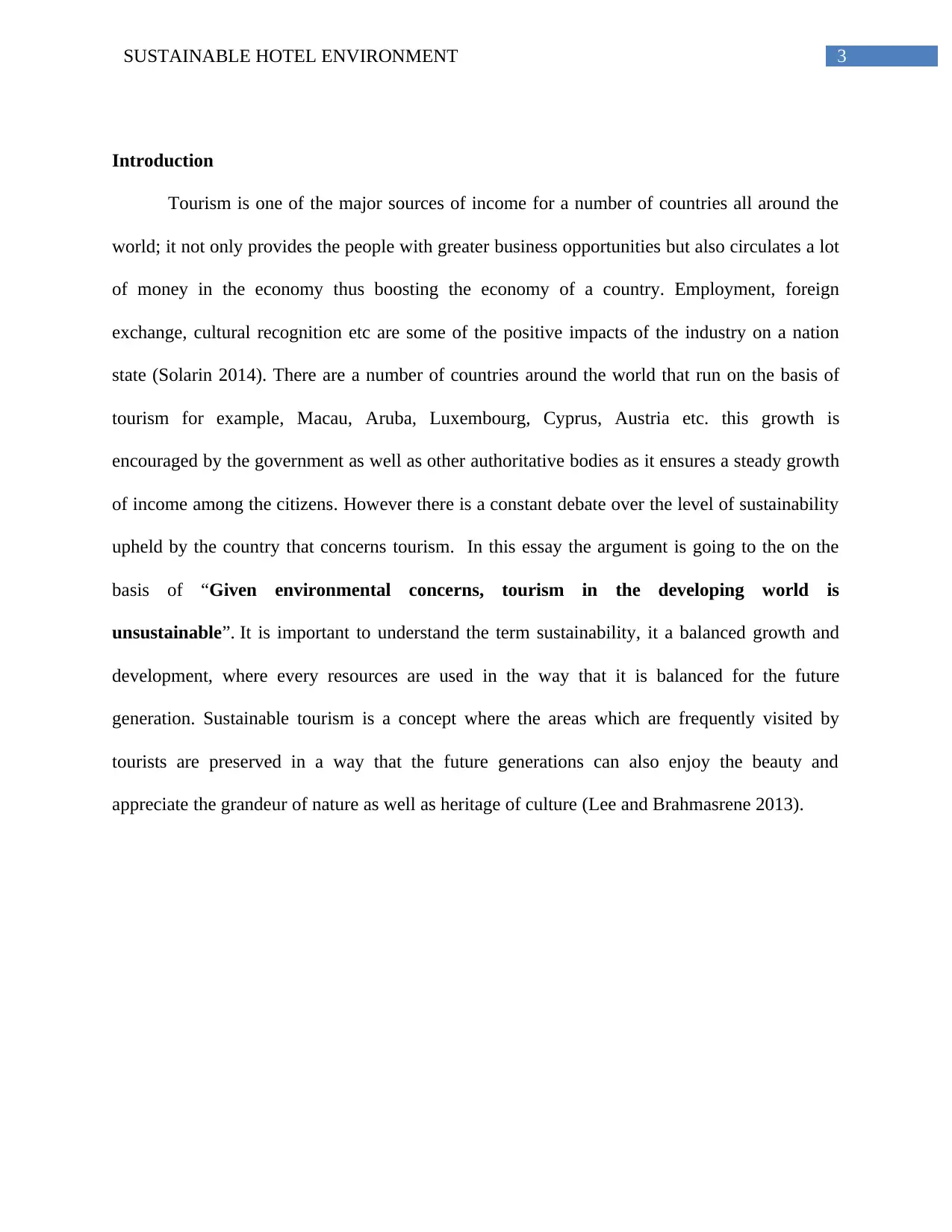
3SUSTAINABLE HOTEL ENVIRONMENT
Introduction
Tourism is one of the major sources of income for a number of countries all around the
world; it not only provides the people with greater business opportunities but also circulates a lot
of money in the economy thus boosting the economy of a country. Employment, foreign
exchange, cultural recognition etc are some of the positive impacts of the industry on a nation
state (Solarin 2014). There are a number of countries around the world that run on the basis of
tourism for example, Macau, Aruba, Luxembourg, Cyprus, Austria etc. this growth is
encouraged by the government as well as other authoritative bodies as it ensures a steady growth
of income among the citizens. However there is a constant debate over the level of sustainability
upheld by the country that concerns tourism. In this essay the argument is going to the on the
basis of “Given environmental concerns, tourism in the developing world is
unsustainable”. It is important to understand the term sustainability, it a balanced growth and
development, where every resources are used in the way that it is balanced for the future
generation. Sustainable tourism is a concept where the areas which are frequently visited by
tourists are preserved in a way that the future generations can also enjoy the beauty and
appreciate the grandeur of nature as well as heritage of culture (Lee and Brahmasrene 2013).
Introduction
Tourism is one of the major sources of income for a number of countries all around the
world; it not only provides the people with greater business opportunities but also circulates a lot
of money in the economy thus boosting the economy of a country. Employment, foreign
exchange, cultural recognition etc are some of the positive impacts of the industry on a nation
state (Solarin 2014). There are a number of countries around the world that run on the basis of
tourism for example, Macau, Aruba, Luxembourg, Cyprus, Austria etc. this growth is
encouraged by the government as well as other authoritative bodies as it ensures a steady growth
of income among the citizens. However there is a constant debate over the level of sustainability
upheld by the country that concerns tourism. In this essay the argument is going to the on the
basis of “Given environmental concerns, tourism in the developing world is
unsustainable”. It is important to understand the term sustainability, it a balanced growth and
development, where every resources are used in the way that it is balanced for the future
generation. Sustainable tourism is a concept where the areas which are frequently visited by
tourists are preserved in a way that the future generations can also enjoy the beauty and
appreciate the grandeur of nature as well as heritage of culture (Lee and Brahmasrene 2013).
Paraphrase This Document
Need a fresh take? Get an instant paraphrase of this document with our AI Paraphraser
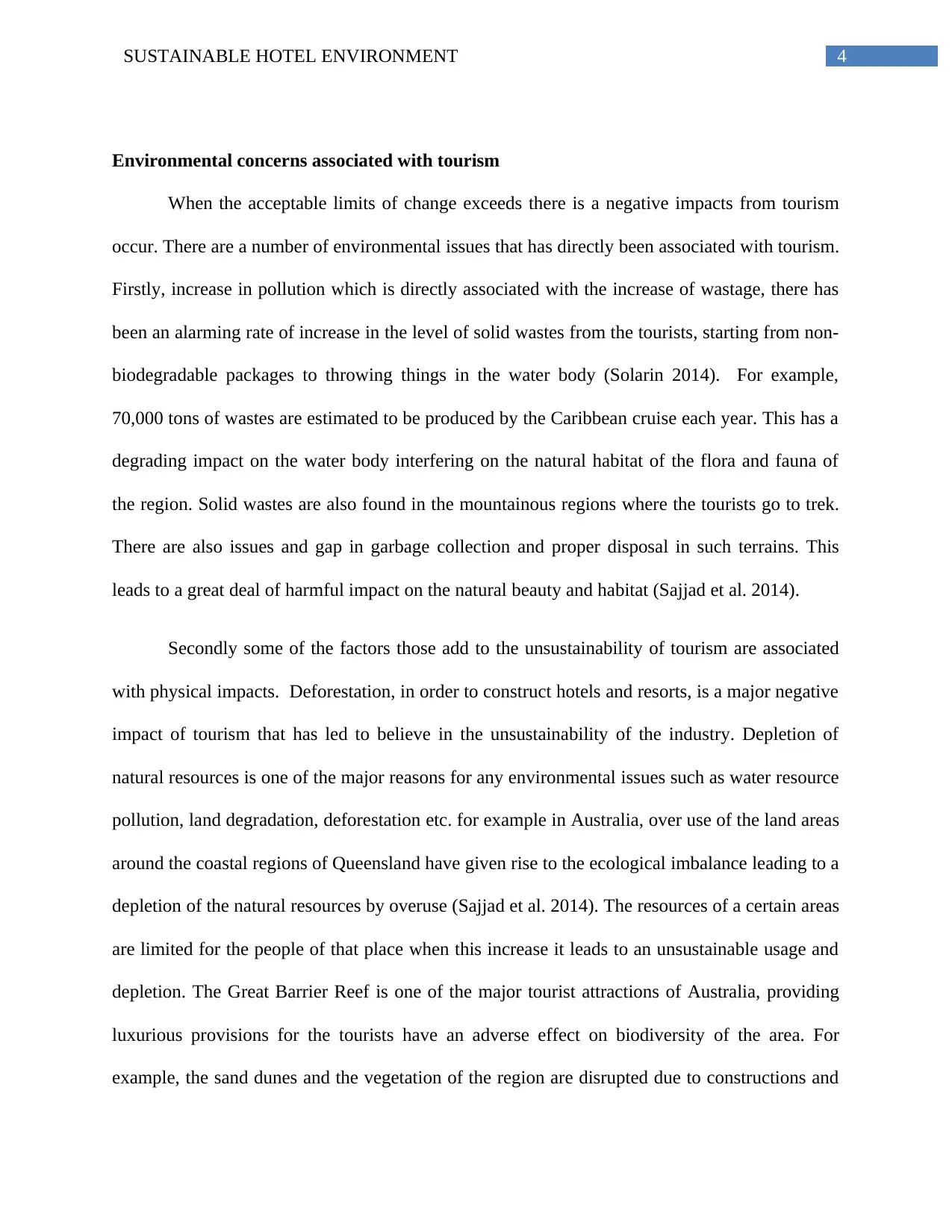
4SUSTAINABLE HOTEL ENVIRONMENT
Environmental concerns associated with tourism
When the acceptable limits of change exceeds there is a negative impacts from tourism
occur. There are a number of environmental issues that has directly been associated with tourism.
Firstly, increase in pollution which is directly associated with the increase of wastage, there has
been an alarming rate of increase in the level of solid wastes from the tourists, starting from non-
biodegradable packages to throwing things in the water body (Solarin 2014). For example,
70,000 tons of wastes are estimated to be produced by the Caribbean cruise each year. This has a
degrading impact on the water body interfering on the natural habitat of the flora and fauna of
the region. Solid wastes are also found in the mountainous regions where the tourists go to trek.
There are also issues and gap in garbage collection and proper disposal in such terrains. This
leads to a great deal of harmful impact on the natural beauty and habitat (Sajjad et al. 2014).
Secondly some of the factors those add to the unsustainability of tourism are associated
with physical impacts. Deforestation, in order to construct hotels and resorts, is a major negative
impact of tourism that has led to believe in the unsustainability of the industry. Depletion of
natural resources is one of the major reasons for any environmental issues such as water resource
pollution, land degradation, deforestation etc. for example in Australia, over use of the land areas
around the coastal regions of Queensland have given rise to the ecological imbalance leading to a
depletion of the natural resources by overuse (Sajjad et al. 2014). The resources of a certain areas
are limited for the people of that place when this increase it leads to an unsustainable usage and
depletion. The Great Barrier Reef is one of the major tourist attractions of Australia, providing
luxurious provisions for the tourists have an adverse effect on biodiversity of the area. For
example, the sand dunes and the vegetation of the region are disrupted due to constructions and
Environmental concerns associated with tourism
When the acceptable limits of change exceeds there is a negative impacts from tourism
occur. There are a number of environmental issues that has directly been associated with tourism.
Firstly, increase in pollution which is directly associated with the increase of wastage, there has
been an alarming rate of increase in the level of solid wastes from the tourists, starting from non-
biodegradable packages to throwing things in the water body (Solarin 2014). For example,
70,000 tons of wastes are estimated to be produced by the Caribbean cruise each year. This has a
degrading impact on the water body interfering on the natural habitat of the flora and fauna of
the region. Solid wastes are also found in the mountainous regions where the tourists go to trek.
There are also issues and gap in garbage collection and proper disposal in such terrains. This
leads to a great deal of harmful impact on the natural beauty and habitat (Sajjad et al. 2014).
Secondly some of the factors those add to the unsustainability of tourism are associated
with physical impacts. Deforestation, in order to construct hotels and resorts, is a major negative
impact of tourism that has led to believe in the unsustainability of the industry. Depletion of
natural resources is one of the major reasons for any environmental issues such as water resource
pollution, land degradation, deforestation etc. for example in Australia, over use of the land areas
around the coastal regions of Queensland have given rise to the ecological imbalance leading to a
depletion of the natural resources by overuse (Sajjad et al. 2014). The resources of a certain areas
are limited for the people of that place when this increase it leads to an unsustainable usage and
depletion. The Great Barrier Reef is one of the major tourist attractions of Australia, providing
luxurious provisions for the tourists have an adverse effect on biodiversity of the area. For
example, the sand dunes and the vegetation of the region are disrupted due to constructions and
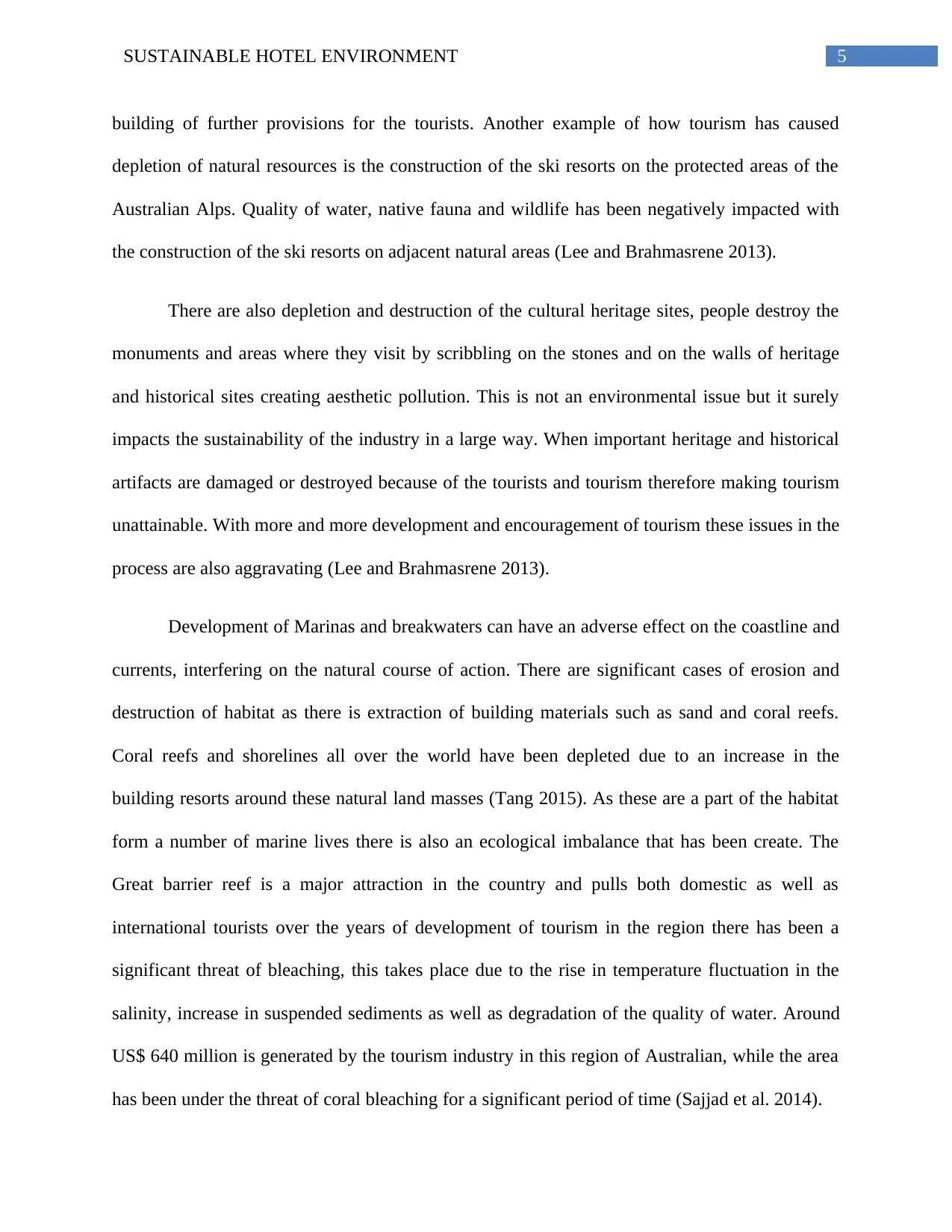
5SUSTAINABLE HOTEL ENVIRONMENT
building of further provisions for the tourists. Another example of how tourism has caused
depletion of natural resources is the construction of the ski resorts on the protected areas of the
Australian Alps. Quality of water, native fauna and wildlife has been negatively impacted with
the construction of the ski resorts on adjacent natural areas (Lee and Brahmasrene 2013).
There are also depletion and destruction of the cultural heritage sites, people destroy the
monuments and areas where they visit by scribbling on the stones and on the walls of heritage
and historical sites creating aesthetic pollution. This is not an environmental issue but it surely
impacts the sustainability of the industry in a large way. When important heritage and historical
artifacts are damaged or destroyed because of the tourists and tourism therefore making tourism
unattainable. With more and more development and encouragement of tourism these issues in the
process are also aggravating (Lee and Brahmasrene 2013).
Development of Marinas and breakwaters can have an adverse effect on the coastline and
currents, interfering on the natural course of action. There are significant cases of erosion and
destruction of habitat as there is extraction of building materials such as sand and coral reefs.
Coral reefs and shorelines all over the world have been depleted due to an increase in the
building resorts around these natural land masses (Tang 2015). As these are a part of the habitat
form a number of marine lives there is also an ecological imbalance that has been create. The
Great barrier reef is a major attraction in the country and pulls both domestic as well as
international tourists over the years of development of tourism in the region there has been a
significant threat of bleaching, this takes place due to the rise in temperature fluctuation in the
salinity, increase in suspended sediments as well as degradation of the quality of water. Around
US$ 640 million is generated by the tourism industry in this region of Australian, while the area
has been under the threat of coral bleaching for a significant period of time (Sajjad et al. 2014).
building of further provisions for the tourists. Another example of how tourism has caused
depletion of natural resources is the construction of the ski resorts on the protected areas of the
Australian Alps. Quality of water, native fauna and wildlife has been negatively impacted with
the construction of the ski resorts on adjacent natural areas (Lee and Brahmasrene 2013).
There are also depletion and destruction of the cultural heritage sites, people destroy the
monuments and areas where they visit by scribbling on the stones and on the walls of heritage
and historical sites creating aesthetic pollution. This is not an environmental issue but it surely
impacts the sustainability of the industry in a large way. When important heritage and historical
artifacts are damaged or destroyed because of the tourists and tourism therefore making tourism
unattainable. With more and more development and encouragement of tourism these issues in the
process are also aggravating (Lee and Brahmasrene 2013).
Development of Marinas and breakwaters can have an adverse effect on the coastline and
currents, interfering on the natural course of action. There are significant cases of erosion and
destruction of habitat as there is extraction of building materials such as sand and coral reefs.
Coral reefs and shorelines all over the world have been depleted due to an increase in the
building resorts around these natural land masses (Tang 2015). As these are a part of the habitat
form a number of marine lives there is also an ecological imbalance that has been create. The
Great barrier reef is a major attraction in the country and pulls both domestic as well as
international tourists over the years of development of tourism in the region there has been a
significant threat of bleaching, this takes place due to the rise in temperature fluctuation in the
salinity, increase in suspended sediments as well as degradation of the quality of water. Around
US$ 640 million is generated by the tourism industry in this region of Australian, while the area
has been under the threat of coral bleaching for a significant period of time (Sajjad et al. 2014).
⊘ This is a preview!⊘
Do you want full access?
Subscribe today to unlock all pages.

Trusted by 1+ million students worldwide
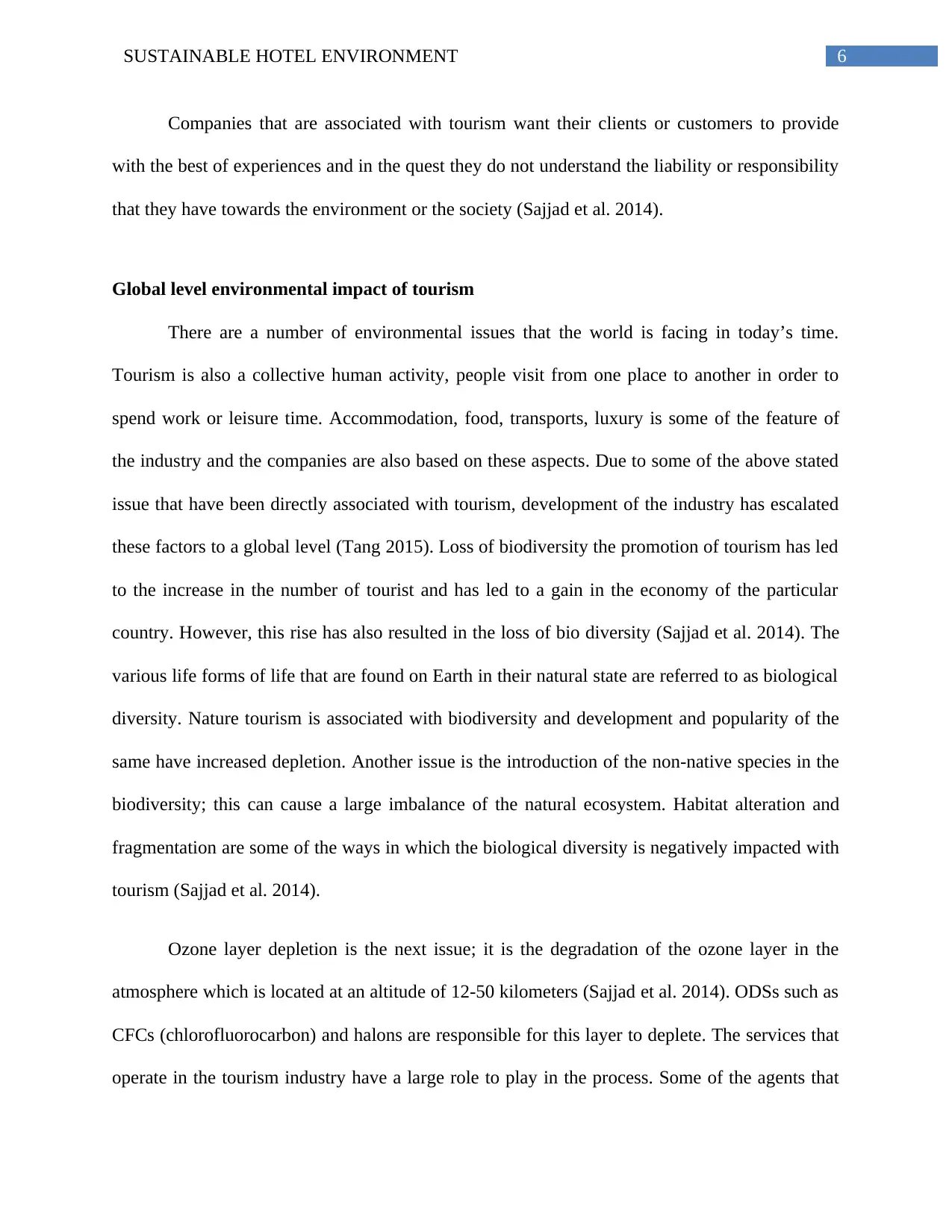
6SUSTAINABLE HOTEL ENVIRONMENT
Companies that are associated with tourism want their clients or customers to provide
with the best of experiences and in the quest they do not understand the liability or responsibility
that they have towards the environment or the society (Sajjad et al. 2014).
Global level environmental impact of tourism
There are a number of environmental issues that the world is facing in today’s time.
Tourism is also a collective human activity, people visit from one place to another in order to
spend work or leisure time. Accommodation, food, transports, luxury is some of the feature of
the industry and the companies are also based on these aspects. Due to some of the above stated
issue that have been directly associated with tourism, development of the industry has escalated
these factors to a global level (Tang 2015). Loss of biodiversity the promotion of tourism has led
to the increase in the number of tourist and has led to a gain in the economy of the particular
country. However, this rise has also resulted in the loss of bio diversity (Sajjad et al. 2014). The
various life forms of life that are found on Earth in their natural state are referred to as biological
diversity. Nature tourism is associated with biodiversity and development and popularity of the
same have increased depletion. Another issue is the introduction of the non-native species in the
biodiversity; this can cause a large imbalance of the natural ecosystem. Habitat alteration and
fragmentation are some of the ways in which the biological diversity is negatively impacted with
tourism (Sajjad et al. 2014).
Ozone layer depletion is the next issue; it is the degradation of the ozone layer in the
atmosphere which is located at an altitude of 12-50 kilometers (Sajjad et al. 2014). ODSs such as
CFCs (chlorofluorocarbon) and halons are responsible for this layer to deplete. The services that
operate in the tourism industry have a large role to play in the process. Some of the agents that
Companies that are associated with tourism want their clients or customers to provide
with the best of experiences and in the quest they do not understand the liability or responsibility
that they have towards the environment or the society (Sajjad et al. 2014).
Global level environmental impact of tourism
There are a number of environmental issues that the world is facing in today’s time.
Tourism is also a collective human activity, people visit from one place to another in order to
spend work or leisure time. Accommodation, food, transports, luxury is some of the feature of
the industry and the companies are also based on these aspects. Due to some of the above stated
issue that have been directly associated with tourism, development of the industry has escalated
these factors to a global level (Tang 2015). Loss of biodiversity the promotion of tourism has led
to the increase in the number of tourist and has led to a gain in the economy of the particular
country. However, this rise has also resulted in the loss of bio diversity (Sajjad et al. 2014). The
various life forms of life that are found on Earth in their natural state are referred to as biological
diversity. Nature tourism is associated with biodiversity and development and popularity of the
same have increased depletion. Another issue is the introduction of the non-native species in the
biodiversity; this can cause a large imbalance of the natural ecosystem. Habitat alteration and
fragmentation are some of the ways in which the biological diversity is negatively impacted with
tourism (Sajjad et al. 2014).
Ozone layer depletion is the next issue; it is the degradation of the ozone layer in the
atmosphere which is located at an altitude of 12-50 kilometers (Sajjad et al. 2014). ODSs such as
CFCs (chlorofluorocarbon) and halons are responsible for this layer to deplete. The services that
operate in the tourism industry have a large role to play in the process. Some of the agents that
Paraphrase This Document
Need a fresh take? Get an instant paraphrase of this document with our AI Paraphraser
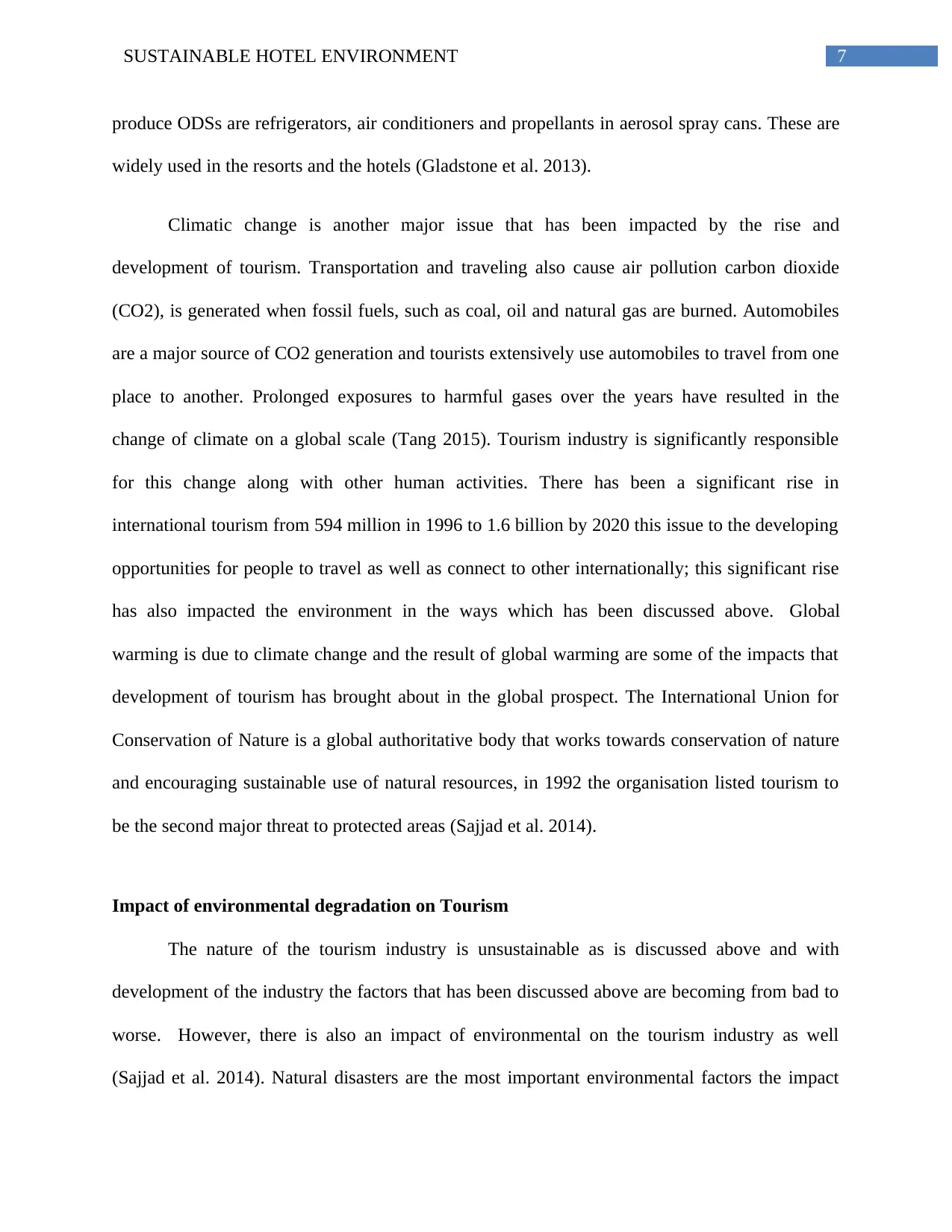
7SUSTAINABLE HOTEL ENVIRONMENT
produce ODSs are refrigerators, air conditioners and propellants in aerosol spray cans. These are
widely used in the resorts and the hotels (Gladstone et al. 2013).
Climatic change is another major issue that has been impacted by the rise and
development of tourism. Transportation and traveling also cause air pollution carbon dioxide
(CO2), is generated when fossil fuels, such as coal, oil and natural gas are burned. Automobiles
are a major source of CO2 generation and tourists extensively use automobiles to travel from one
place to another. Prolonged exposures to harmful gases over the years have resulted in the
change of climate on a global scale (Tang 2015). Tourism industry is significantly responsible
for this change along with other human activities. There has been a significant rise in
international tourism from 594 million in 1996 to 1.6 billion by 2020 this issue to the developing
opportunities for people to travel as well as connect to other internationally; this significant rise
has also impacted the environment in the ways which has been discussed above. Global
warming is due to climate change and the result of global warming are some of the impacts that
development of tourism has brought about in the global prospect. The International Union for
Conservation of Nature is a global authoritative body that works towards conservation of nature
and encouraging sustainable use of natural resources, in 1992 the organisation listed tourism to
be the second major threat to protected areas (Sajjad et al. 2014).
Impact of environmental degradation on Tourism
The nature of the tourism industry is unsustainable as is discussed above and with
development of the industry the factors that has been discussed above are becoming from bad to
worse. However, there is also an impact of environmental on the tourism industry as well
(Sajjad et al. 2014). Natural disasters are the most important environmental factors the impact
produce ODSs are refrigerators, air conditioners and propellants in aerosol spray cans. These are
widely used in the resorts and the hotels (Gladstone et al. 2013).
Climatic change is another major issue that has been impacted by the rise and
development of tourism. Transportation and traveling also cause air pollution carbon dioxide
(CO2), is generated when fossil fuels, such as coal, oil and natural gas are burned. Automobiles
are a major source of CO2 generation and tourists extensively use automobiles to travel from one
place to another. Prolonged exposures to harmful gases over the years have resulted in the
change of climate on a global scale (Tang 2015). Tourism industry is significantly responsible
for this change along with other human activities. There has been a significant rise in
international tourism from 594 million in 1996 to 1.6 billion by 2020 this issue to the developing
opportunities for people to travel as well as connect to other internationally; this significant rise
has also impacted the environment in the ways which has been discussed above. Global
warming is due to climate change and the result of global warming are some of the impacts that
development of tourism has brought about in the global prospect. The International Union for
Conservation of Nature is a global authoritative body that works towards conservation of nature
and encouraging sustainable use of natural resources, in 1992 the organisation listed tourism to
be the second major threat to protected areas (Sajjad et al. 2014).
Impact of environmental degradation on Tourism
The nature of the tourism industry is unsustainable as is discussed above and with
development of the industry the factors that has been discussed above are becoming from bad to
worse. However, there is also an impact of environmental on the tourism industry as well
(Sajjad et al. 2014). Natural disasters are the most important environmental factors the impact
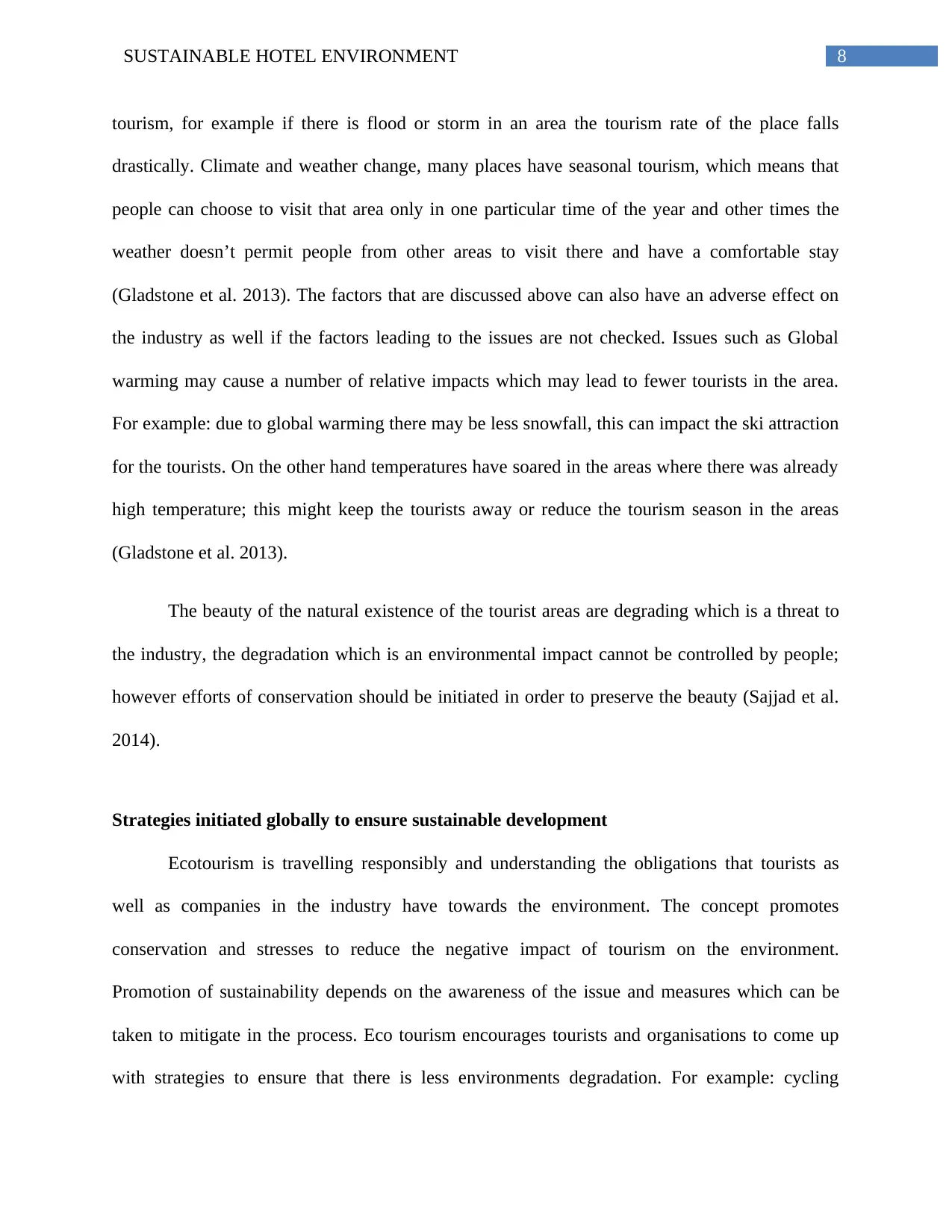
8SUSTAINABLE HOTEL ENVIRONMENT
tourism, for example if there is flood or storm in an area the tourism rate of the place falls
drastically. Climate and weather change, many places have seasonal tourism, which means that
people can choose to visit that area only in one particular time of the year and other times the
weather doesn’t permit people from other areas to visit there and have a comfortable stay
(Gladstone et al. 2013). The factors that are discussed above can also have an adverse effect on
the industry as well if the factors leading to the issues are not checked. Issues such as Global
warming may cause a number of relative impacts which may lead to fewer tourists in the area.
For example: due to global warming there may be less snowfall, this can impact the ski attraction
for the tourists. On the other hand temperatures have soared in the areas where there was already
high temperature; this might keep the tourists away or reduce the tourism season in the areas
(Gladstone et al. 2013).
The beauty of the natural existence of the tourist areas are degrading which is a threat to
the industry, the degradation which is an environmental impact cannot be controlled by people;
however efforts of conservation should be initiated in order to preserve the beauty (Sajjad et al.
2014).
Strategies initiated globally to ensure sustainable development
Ecotourism is travelling responsibly and understanding the obligations that tourists as
well as companies in the industry have towards the environment. The concept promotes
conservation and stresses to reduce the negative impact of tourism on the environment.
Promotion of sustainability depends on the awareness of the issue and measures which can be
taken to mitigate in the process. Eco tourism encourages tourists and organisations to come up
with strategies to ensure that there is less environments degradation. For example: cycling
tourism, for example if there is flood or storm in an area the tourism rate of the place falls
drastically. Climate and weather change, many places have seasonal tourism, which means that
people can choose to visit that area only in one particular time of the year and other times the
weather doesn’t permit people from other areas to visit there and have a comfortable stay
(Gladstone et al. 2013). The factors that are discussed above can also have an adverse effect on
the industry as well if the factors leading to the issues are not checked. Issues such as Global
warming may cause a number of relative impacts which may lead to fewer tourists in the area.
For example: due to global warming there may be less snowfall, this can impact the ski attraction
for the tourists. On the other hand temperatures have soared in the areas where there was already
high temperature; this might keep the tourists away or reduce the tourism season in the areas
(Gladstone et al. 2013).
The beauty of the natural existence of the tourist areas are degrading which is a threat to
the industry, the degradation which is an environmental impact cannot be controlled by people;
however efforts of conservation should be initiated in order to preserve the beauty (Sajjad et al.
2014).
Strategies initiated globally to ensure sustainable development
Ecotourism is travelling responsibly and understanding the obligations that tourists as
well as companies in the industry have towards the environment. The concept promotes
conservation and stresses to reduce the negative impact of tourism on the environment.
Promotion of sustainability depends on the awareness of the issue and measures which can be
taken to mitigate in the process. Eco tourism encourages tourists and organisations to come up
with strategies to ensure that there is less environments degradation. For example: cycling
⊘ This is a preview!⊘
Do you want full access?
Subscribe today to unlock all pages.

Trusted by 1+ million students worldwide
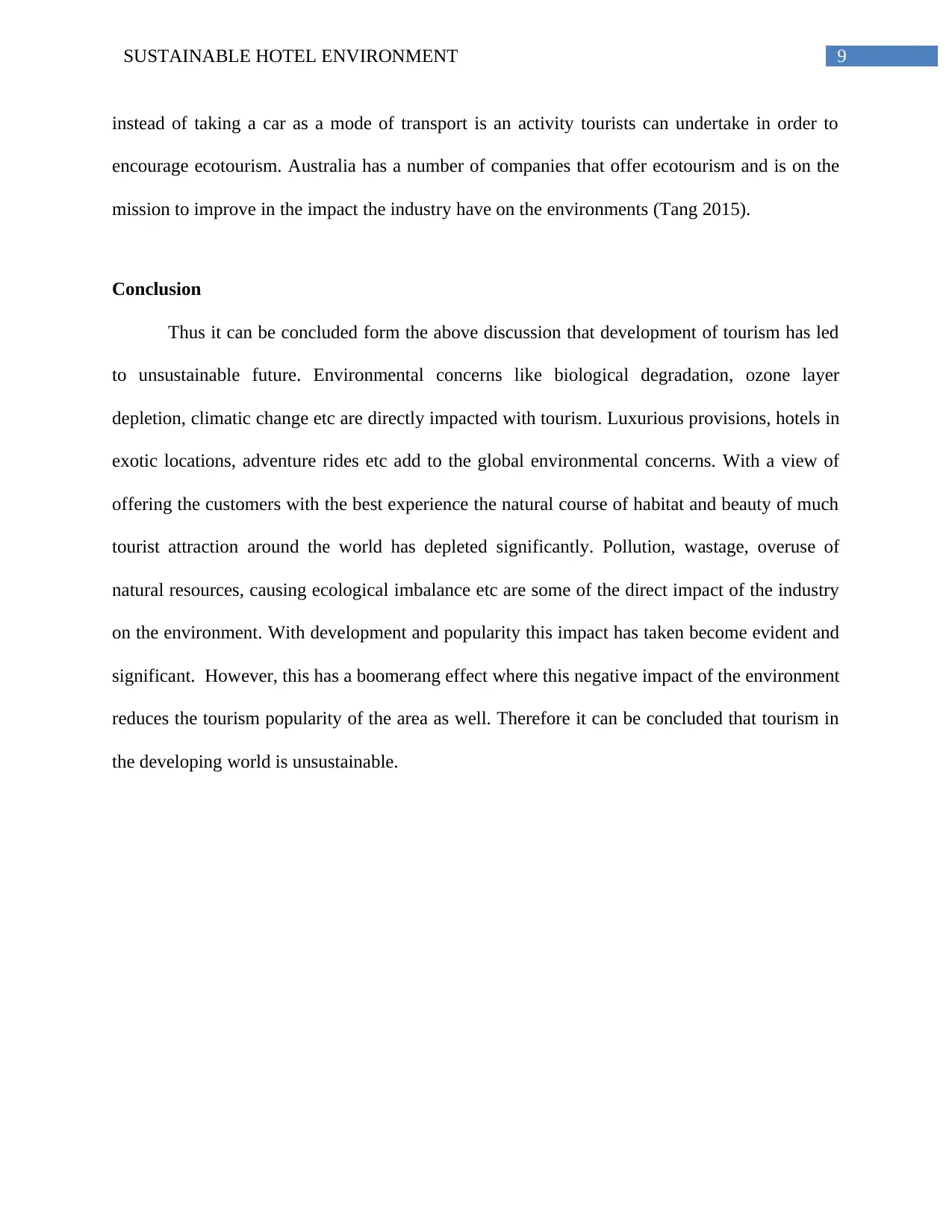
9SUSTAINABLE HOTEL ENVIRONMENT
instead of taking a car as a mode of transport is an activity tourists can undertake in order to
encourage ecotourism. Australia has a number of companies that offer ecotourism and is on the
mission to improve in the impact the industry have on the environments (Tang 2015).
Conclusion
Thus it can be concluded form the above discussion that development of tourism has led
to unsustainable future. Environmental concerns like biological degradation, ozone layer
depletion, climatic change etc are directly impacted with tourism. Luxurious provisions, hotels in
exotic locations, adventure rides etc add to the global environmental concerns. With a view of
offering the customers with the best experience the natural course of habitat and beauty of much
tourist attraction around the world has depleted significantly. Pollution, wastage, overuse of
natural resources, causing ecological imbalance etc are some of the direct impact of the industry
on the environment. With development and popularity this impact has taken become evident and
significant. However, this has a boomerang effect where this negative impact of the environment
reduces the tourism popularity of the area as well. Therefore it can be concluded that tourism in
the developing world is unsustainable.
instead of taking a car as a mode of transport is an activity tourists can undertake in order to
encourage ecotourism. Australia has a number of companies that offer ecotourism and is on the
mission to improve in the impact the industry have on the environments (Tang 2015).
Conclusion
Thus it can be concluded form the above discussion that development of tourism has led
to unsustainable future. Environmental concerns like biological degradation, ozone layer
depletion, climatic change etc are directly impacted with tourism. Luxurious provisions, hotels in
exotic locations, adventure rides etc add to the global environmental concerns. With a view of
offering the customers with the best experience the natural course of habitat and beauty of much
tourist attraction around the world has depleted significantly. Pollution, wastage, overuse of
natural resources, causing ecological imbalance etc are some of the direct impact of the industry
on the environment. With development and popularity this impact has taken become evident and
significant. However, this has a boomerang effect where this negative impact of the environment
reduces the tourism popularity of the area as well. Therefore it can be concluded that tourism in
the developing world is unsustainable.
Paraphrase This Document
Need a fresh take? Get an instant paraphrase of this document with our AI Paraphraser
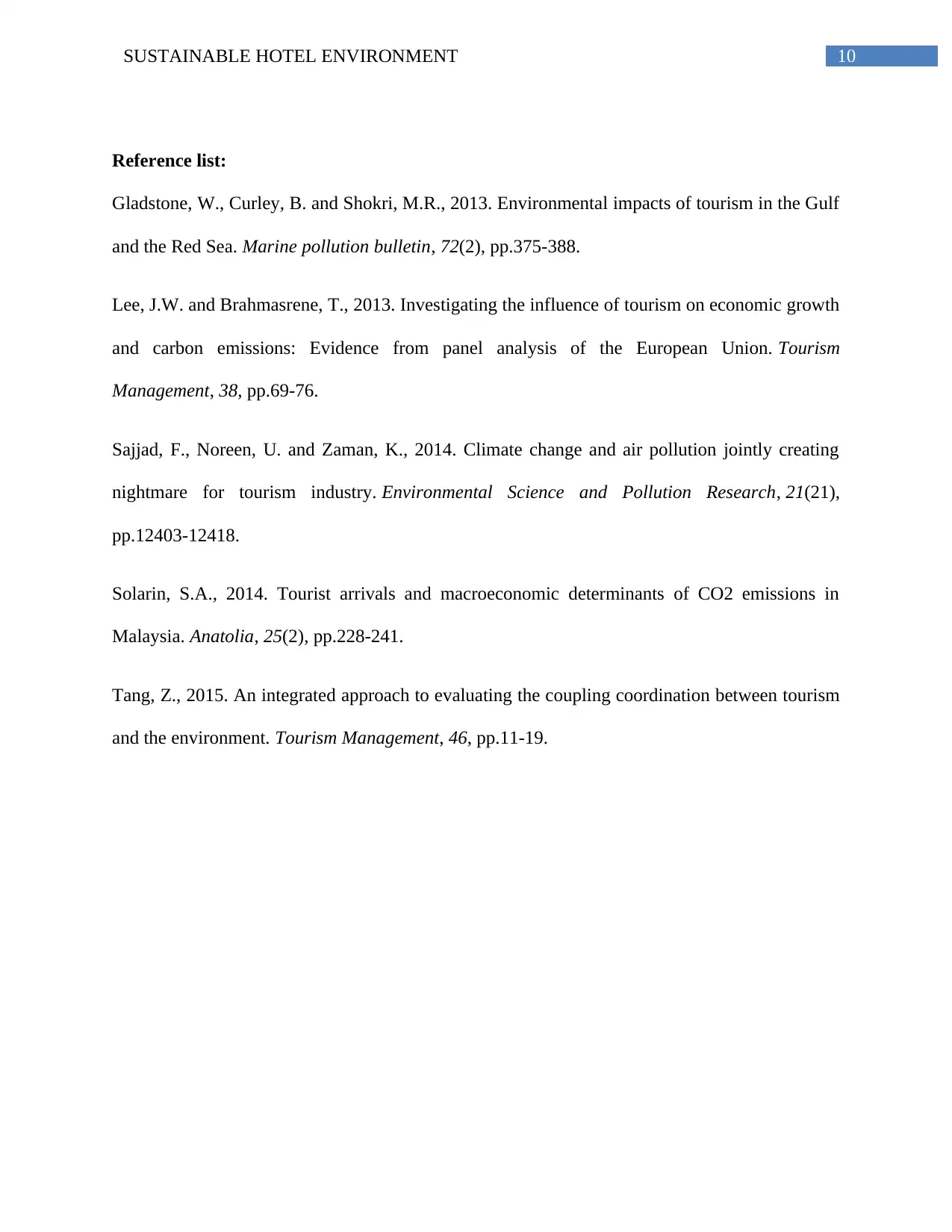
10SUSTAINABLE HOTEL ENVIRONMENT
Reference list:
Gladstone, W., Curley, B. and Shokri, M.R., 2013. Environmental impacts of tourism in the Gulf
and the Red Sea. Marine pollution bulletin, 72(2), pp.375-388.
Lee, J.W. and Brahmasrene, T., 2013. Investigating the influence of tourism on economic growth
and carbon emissions: Evidence from panel analysis of the European Union. Tourism
Management, 38, pp.69-76.
Sajjad, F., Noreen, U. and Zaman, K., 2014. Climate change and air pollution jointly creating
nightmare for tourism industry. Environmental Science and Pollution Research, 21(21),
pp.12403-12418.
Solarin, S.A., 2014. Tourist arrivals and macroeconomic determinants of CO2 emissions in
Malaysia. Anatolia, 25(2), pp.228-241.
Tang, Z., 2015. An integrated approach to evaluating the coupling coordination between tourism
and the environment. Tourism Management, 46, pp.11-19.
Reference list:
Gladstone, W., Curley, B. and Shokri, M.R., 2013. Environmental impacts of tourism in the Gulf
and the Red Sea. Marine pollution bulletin, 72(2), pp.375-388.
Lee, J.W. and Brahmasrene, T., 2013. Investigating the influence of tourism on economic growth
and carbon emissions: Evidence from panel analysis of the European Union. Tourism
Management, 38, pp.69-76.
Sajjad, F., Noreen, U. and Zaman, K., 2014. Climate change and air pollution jointly creating
nightmare for tourism industry. Environmental Science and Pollution Research, 21(21),
pp.12403-12418.
Solarin, S.A., 2014. Tourist arrivals and macroeconomic determinants of CO2 emissions in
Malaysia. Anatolia, 25(2), pp.228-241.
Tang, Z., 2015. An integrated approach to evaluating the coupling coordination between tourism
and the environment. Tourism Management, 46, pp.11-19.
1 out of 11
Related Documents
Your All-in-One AI-Powered Toolkit for Academic Success.
+13062052269
info@desklib.com
Available 24*7 on WhatsApp / Email
![[object Object]](/_next/static/media/star-bottom.7253800d.svg)
Unlock your academic potential
Copyright © 2020–2025 A2Z Services. All Rights Reserved. Developed and managed by ZUCOL.




